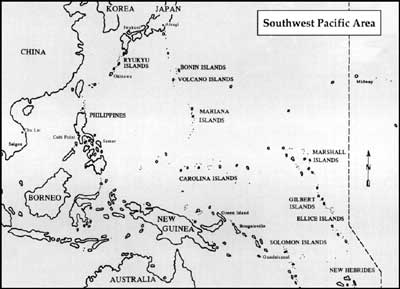| Marines in World War II Commemorative Series |
|
. . . AND A FEW MARINES: Marines in the Liberation of the Philippines by Captain John C. Chapin, USMCR (Ret) It was apparently an insignificant event when a few Marine planes flew into a muddy airfield at Tacloban on the island of Leyte in the Philippines on 3 December 1944. All around them were the elements of the massive U.S. Army invasion which had begun on 20 October. Seven infantry divisions and six Army Air Force (AAF) air groups dominated the island scene. It was the start of a major campaign in which Marine aviation would play a major role.
The first Marine planes to arrive that day were 12 Grumman F6F Hellcat night fighters of VMF(N)- 541, nicknamed the "Bateye" squadron. They had flown the 602 miles from their base on Peleliu in the Palau Islands. A few hours later 66 Chance-Vought F4U Corsair Marine fighters roared in to join them at the crowded strip, after a series of island-hopping stops on their 1,957-mile trip from Emirau in the Bismarck Archipelago. These Corsairs were the advance guard of the 85 planes coming from VMF-115, -211, -218, and -313 of Marine Aircraft Group (MAG) 12 in the Solomon Islands. They would serve as part of the 308th Bombardment Wing of the Fifth Army Air Force under Major General Ennis C. Whitehead, USA. The same day they arrived, six night fighters of the "Bateye" squadron were already back in the air for their first mission, flying cover for a torpedo boat. It was a small beginning of bigger things to come.
The deployment of Marine planes to the Philippines was an event which seemed unlikely earlier. General Douglas MacArthur, Commander, Southwest Pacific Area, had been deeply committed personally to the recapture of the Philippines ever since his speedy departure from there in 1942 with the ringing promise, "I shall return." On 12 March 1944, the Joint Chiefs of Staff (JCS) issued a directive setting the southernmost island of Mindanao as the first American objective in the Philippines. This prompted Major General Ralph J. Mitchell, commanding general of the 1st Marine Aircraft Wing (MAW) in the northern Solomon Islands, to fly to Australia in May, and again in August, to meet with General MacArthur and his air chief, Lieutenant General George C. Kenney, and strenuously urge the use of Marine aviation in the impending campaign. His reasons were compelling: Japanese air power was by now almost wholly eliminated in the northern Solomons and his squadrons were battle-hardened from 22 months of almost continuous air operations. General Mitchell hit a stone wall: This was to be an all-Army operation.
Then a new factor emerged in the strategic planning. Subsequent air strikes on 12 September by Admiral William F. Halsey's Third Fleet fast carrier force, scourging the island of Leyte (in the central Philippines), revealed that Japanese defenses there were much weaker than expected. Accordingly, the JCS issued a new directive on 15 September 1944, setting Leyte as the target for a 20 October landing. With this objective a considerable distance away from the Marines' Solomon squadrons, the outlook for their involvement in the Philippines campaign seemed not to be in the cards.
|






